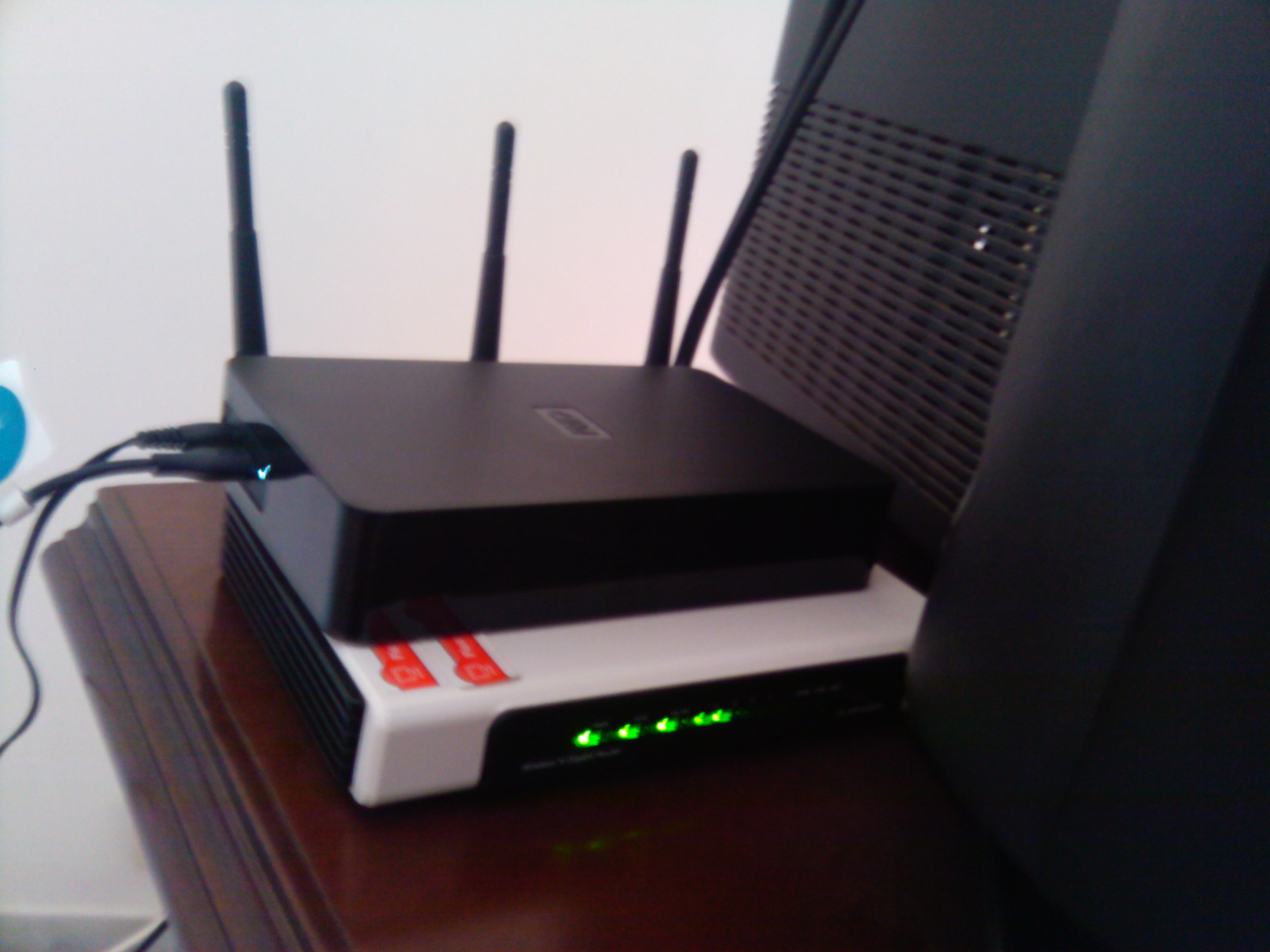Differenze tra le versioni 2 e 10 (in 8 versioni)
|
Dimensione: 2247
Commento:
|
← Versione 10 del 2011-11-06 13:15:05 ⇥
Dimensione: 5821
Commento:
|
| Le cancellazioni sono segnalate in questo modo. | Le aggiunte sono segnalate in questo modo. |
| Linea 1: | Linea 1: |
| = How to make a NAS with an OpenWrt router = | = How to make a Samba NAS with an OpenWrt router = This express howto describes how to create a [[https://secure.wikimedia.org/wikipedia/en/wiki/Network-attached_storage|NAS]] to share files inside a network out of an USB-capable OpenWrt router and an external hard drive. {{attachment:tplinknas.jpg||height=300}} {{attachment:tplinkfrombehind.jpg||height=300}} <<TableOfContents>> |
| Linea 5: | Linea 11: |
| * OpenWrt router with USB port (such as TP-Link WR1043ND) already flashed with OpenWrt and connected to the Internet | * OpenWrt router with USB port (such as TP-Link WR1043ND) already flashed with OpenWrt Backfire and connected to the Internet |
| Linea 24: | Linea 30: |
| plug the disk into the router's USB port | * plug the disk into the router's USB port |
| Linea 50: | Linea 56: |
| Be sure that sda1 is the name of your hard disk's partition. Edit /etc/config/fstab |
* be sure that sda1 is the name of your hard disk's partition. * edit /etc/config/fstab |
| Linea 78: | Linea 83: |
| Then: | * then: |
| Linea 89: | Linea 94: |
| * now let's samba: {{{ root@QQ:~# mkdir /mnt/share root@QQ:~# opkg install samba3 }}} * edit /etc/config/samba {{{ config samba option 'name' 'QQ' option 'workgroup' 'openwrt' option 'description' 'QQ NAS' option 'homes' '0' config sambashare option 'name' 'share' option 'path' '/mnt/share' option 'read_only' 'read' option 'guest_ok' 'yes' option 'create_mask' '0700' option 'dir_mask' '0700' #option 'users' 'abc' }}} |
|
| Linea 91: | Linea 123: |
| * and enable the samba server: {{{ root@QQ:~# /etc/init.d/samba enable root@QQ:~# /etc/init.d/samba start root@QQ:~# }}} * you can now put all the stuff that you want to share inside the harddisk's 'share' directory :D == Troubleshooting == === external hard disk not mounted === * If you cannot access the samba mount from a PC or if by issuing the mount command the drive does not show up in the list then edit /etc/init.d/fstab and add a "sleep 15" command in the start() function as follows: {{{ start() { . /lib/functions/mount.sh sleep 15 config_load fstab mkdir -p /var/lock lock -w /var/lock/fstab.lck && { lock /var/lock/fstab.lck [ -e /tmp/fstab ] || { echo '# WARNING: this is an auto generated file, please use uci to set defined filesystems' > /tmp/fstab } lock -u /var/lock/fstab.lck } config_foreach do_swapon swap config_foreach do_mount mount config_foreach do_swapon swap # do swap a second time so that swap on filesystems is enabled } }}} |
|
| Linea 95: | Linea 162: |
| * http://wiki.openwrt.org/doc/howto/cifs.server * http://wiki.openwrt.org/doc/uci/samba |
How to make a Samba NAS with an OpenWrt router
This express howto describes how to create a NAS to share files inside a network out of an USB-capable OpenWrt router and an external hard drive.


Indice
Ingredients
OpenWrt router with USB port (such as TP-Link WR1043ND) already flashed with OpenWrt Backfire and connected to the Internet
- external USB hard drive with a single ext4 partition
- cables to connect and power the hardware
Steps
root@QQ:~# opkg update root@QQ:~# opkg install kmod-fs-ext4 root@QQ:~# opkg install kmod-usb-storage root@QQ:~# opkg install block-mount
- plug the disk into the router's USB port
root@QQ:~# dmesg ... SCSI subsystem initialized Initializing USB Mass Storage driver... scsi0 : SCSI emulation for USB Mass Storage devices usbcore: registered new interface driver usb-storage USB Mass Storage support registered. usb-storage: device found at 2 usb-storage: waiting for device to settle before scanning scsi 0:0:0:0: Direct-Access WD Ext HDD 1021 2021 PQ: 0 ANSI: 4 sd 0:0:0:0: [sda] 1953519616 512-byte logical blocks: (1.00 TB/931 GiB) usb-storage: device scan complete sd 0:0:0:0: [sda] Write Protect is off sd 0:0:0:0: [sda] Mode Sense: 17 00 10 08 sd 0:0:0:0: [sda] Assuming drive cache: write through sd 0:0:0:0: [sda] Assuming drive cache: write through sda: sda1 sd 0:0:0:0: [sda] Assuming drive cache: write through sd 0:0:0:0: [sda] Attached SCSI disk
- be sure that sda1 is the name of your hard disk's partition.
- edit /etc/config/fstab
config global automount
option from_fstab 1
option anon_mount 1
config global autoswap
option from_fstab 1
option anon_swap 0
config mount
option target /mnt
option device /dev/sda1
option fstype ext4
option options rw,sync
option enabled 1
option enabled_fsck 0
config swap
option device /dev/sda2
option enabled 0- then:
root@QQ:~# /etc/init.d/fstab enable root@QQ:~# /etc/init.d/fstab start WARNING: /lib/functions/fsck not found root@QQ:~# mount ... /dev/sda1 on /mnt type ext4 (rw,sync,relatime,barrier=1,data=ordered)
- now let's samba:
root@QQ:~# mkdir /mnt/share root@QQ:~# opkg install samba3
- edit /etc/config/samba
config samba
option 'name' 'QQ'
option 'workgroup' 'openwrt'
option 'description' 'QQ NAS'
option 'homes' '0'
config sambashare
option 'name' 'share'
option 'path' '/mnt/share'
option 'read_only' 'read'
option 'guest_ok' 'yes'
option 'create_mask' '0700'
option 'dir_mask' '0700'
#option 'users' 'abc'- and enable the samba server:
root@QQ:~# /etc/init.d/samba enable root@QQ:~# /etc/init.d/samba start root@QQ:~#
you can now put all the stuff that you want to share inside the harddisk's 'share' directory

Troubleshooting
external hard disk not mounted
- If you cannot access the samba mount from a PC or if by issuing the mount command the drive does not show up in the list then edit /etc/init.d/fstab and add a "sleep 15" command in the start() function as follows:
start() {
. /lib/functions/mount.sh
sleep 15
config_load fstab
mkdir -p /var/lock
lock -w /var/lock/fstab.lck && {
lock /var/lock/fstab.lck
[ -e /tmp/fstab ] || {
echo '# WARNING: this is an auto generated file, please use uci to set defined filesystems' > /tmp/fstab
}
lock -u /var/lock/fstab.lck
}
config_foreach do_swapon swap
config_foreach do_mount mount
config_foreach do_swapon swap # do swap a second time so that swap on filesystems is enabled
}








